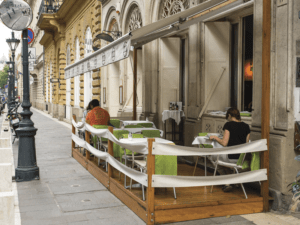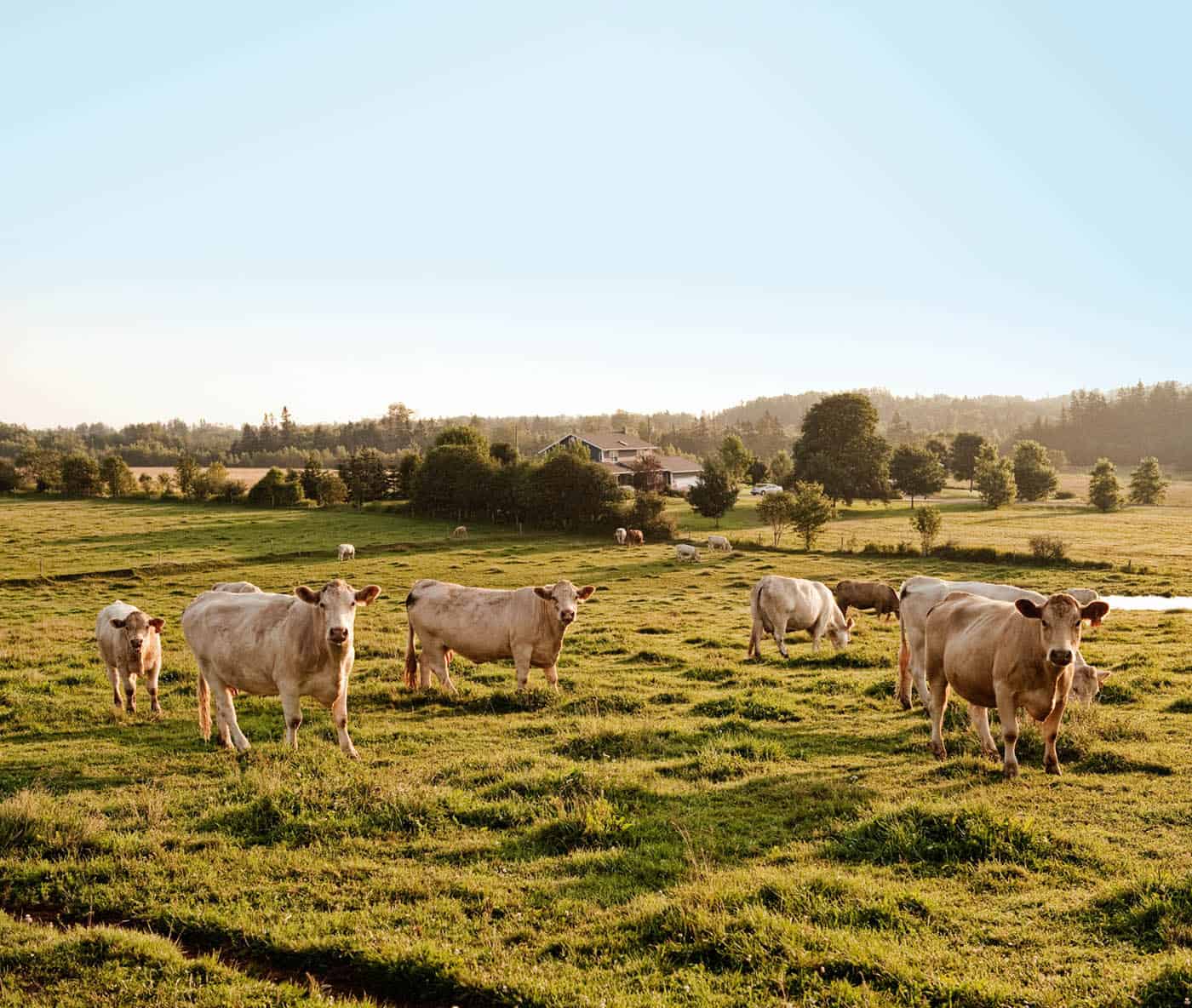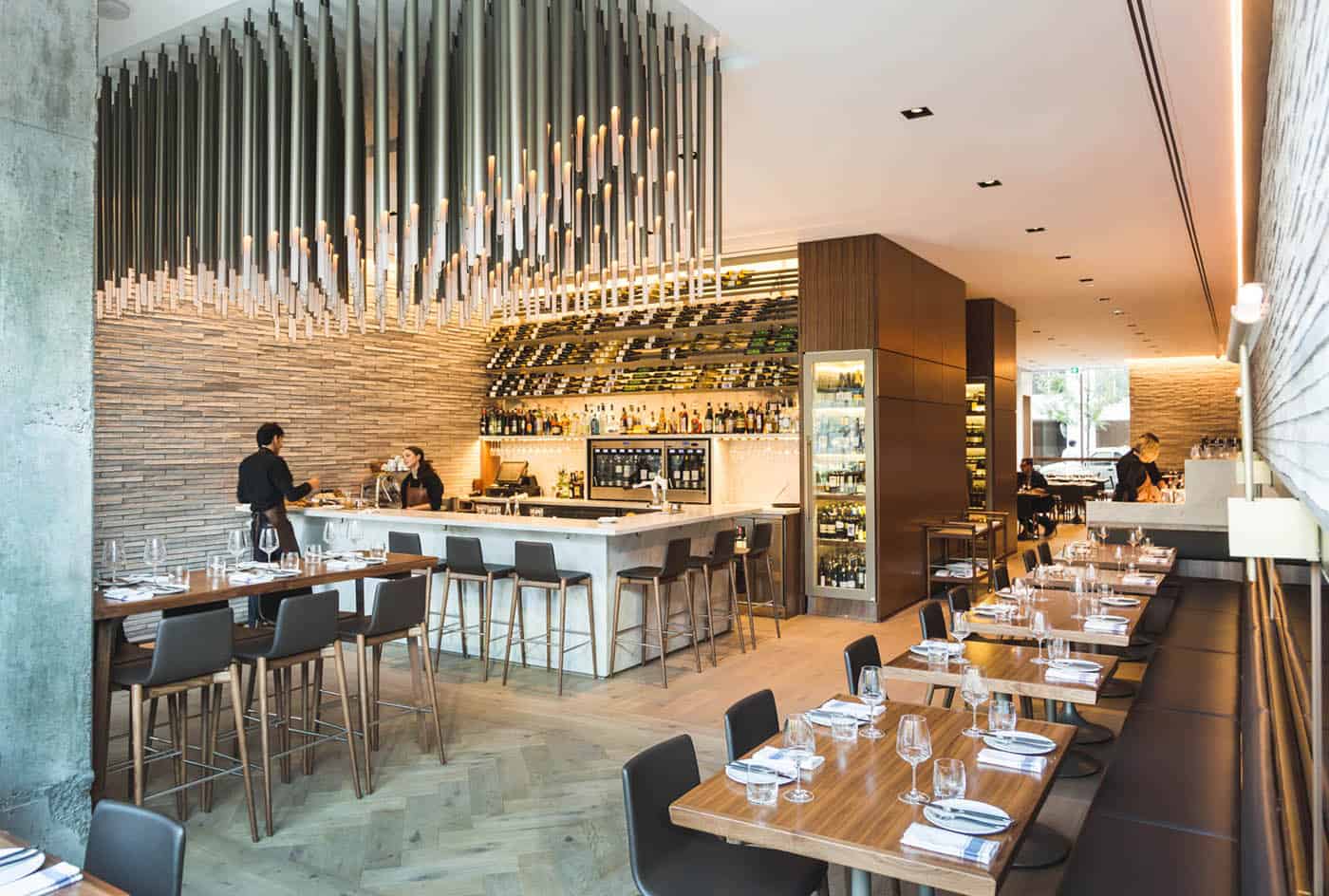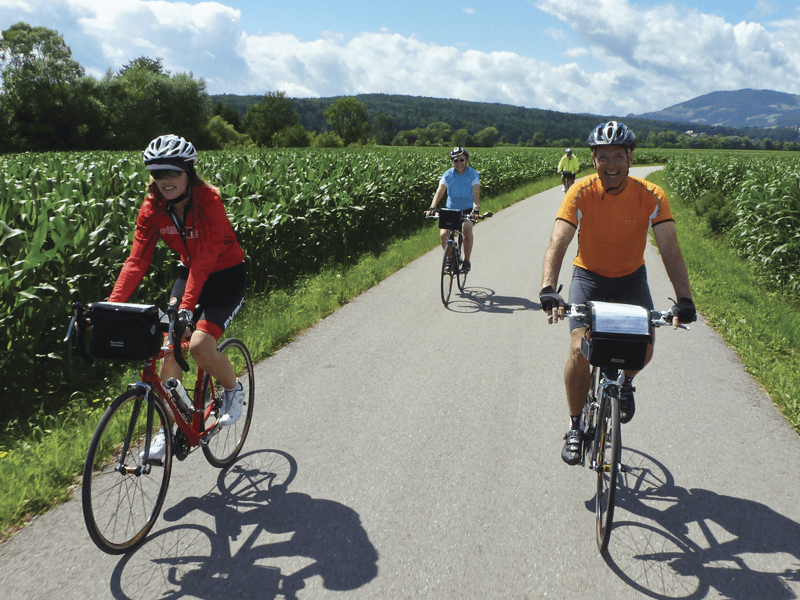
Odyssey On Two Wheels
Jacob Richler tackles a challenging mix of fitness, Riesling and schnitzel on the new Butterfield & Robinson gastro-cycling tour from Vienna to Budapest
MY WIFE LISA AND I have signed up for a five-day jaunt with Butterfield & Robinson, the Canadian-born adventure travel company for fitness-minded sybarites. The itinerary has us making our way from Vienna to Budapest, through the heart of the onetime Austro-Hungarian Empire, stopping in on mouldering palaces, great restaurants and fine wineries with a view. And in theory, anyway, as we are cycling close to 50 km daily, no amount of eating and drinking should prevent us from completing this little odyssey in a condition commensurate with—if not improved from—our condition when we started.
DAY 1:
Our trip begins at 8:30 am on Sunday, June 17, with a quick rendezvous with our cycling group in the lobby of Vienna’s stately Hotel Sacher (yes, the birthplace of the Sachertorte). From there, we take a 45-minute bus ride east, along the south bank of the Danube, until we escape the capital’s traffic and arrive in a small, quiet town named Deutsch-Haslau. There, B&R has set up a temporary base camp in an obliging local resident’s driveway, where our bicycles await.
We are eight cyclists and two guides. Two couples from Minneapolis are old friends and veterans of a half-dozen of these B&R adventures. Another couple, first-timers like us, are from New York. Our two young (and worrisomely fit-looking) guides, Ernesto and Raffa, are European, extensively travelled and fluent in all the necessary languages.
Ernesto begins our briefing with much advice on road safety. Then a little more, just to be safe. And finally, something important: a detailed explanation of how to use our bicycles’ handlebar-mounted tablet computers. Their GPS-connected roadmaps are activated by GPS markers to voice-prompt upcoming turns in the road, distance to the finish line, you name it. With B&R, I surmise, there is no need to follow the leader or the gang; the tablet is our ticket to independence. Good stuff.
The day is glorious, hot and clear, with a mild breeze alleviating the full-on assault of the sun. We set off. Over the next 15 kilometres or so, we learn that Austria has nice bike paths and courteous drivers. And—at least in our neck of the woods—an awful lot of warehouses, garages and bleak roadways. Finally, the scenery begins to improve as we approach Lake Neusiedl— Austria’s largest, albeit not much deeper than a wading pool–and pull up for lunch at Mole West, a large lakeside marina restaurant, for our first group meal.
The Riesling is lovely, the food indifferent, and two hours later we are back on our bikes. And save for the occasional mobile refreshment pit stops that B&R sets up on the roadside, our bike seats are where we stay for the rest of the afternoon, for another two hours and then some of perspiration and exertion.
This five-hours-in-a single-day on a hard bicycle seat is a first for me. I spend some large part of the afternoon telegraphing thank-yous to an old friend back home who talked me into spending what I thought to be an exorbitant sum on a cutting-edge pair of spandex cycling shorts, which have cushioning gel packs stitched into their bottoms—just like a Kardashian.
At last we arrive at our first hotel, Taubenkobel, in the Burgenland village of Schützen am Gebirge. The diminutive property somehow comprises a hotel, restaurant, terrace, gardens and a lily pond filled with unusually loquacious frogs. The compound looks to have grown organically, built very much by hand, all integrated seamlessly into a 19th-century farmhouse with an effect that is equal parts charming, romantic and eccentric.
Actually, no; the emphasis is on the latter. For example, our cozy bedroom— complete with turntable, records and a bar—also has a loft, accessible by ladder and occupied by a knockoff of Allen Jones‘ iconic ’60s sculpture of a semi-naked woman in bondage gear on all fours with a glass table top mounted on her back. I have a martini with her, and then it’s time for dinner.
An exceptional, genuinely exquisite, original and emphatically memorable dinner. Trout crudo with radish and caramel followed by local pike in garlic and rosehip broth, a dazzling course of local charcuterie and one of the single best pigeons (succulent, smoky from the wood fire) I’ve ever tasted. We close with a unique dessert of locally foraged bitter greens, rhubarb and fresh almonds. Each course is paired with an exceptional local wine. We sleep very well.
Visiting Vienna
WHERE TO STAY:
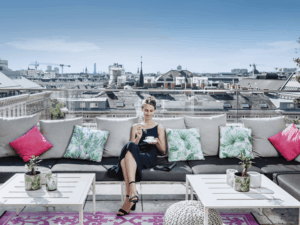 Grand Ferdinand
Grand Ferdinand
Contemporary furnishings, comfortable spacious rooms, a good lobby restaurant and streetside patio bar in the Schubertring, and a complimentary breakfast on a rooftop patio with splendid views of the old city—for a third of the price of the Hotel Sacher.
WHERE TO EAT:
A small, charming fish restaurant with a small sidewalk patio.Excellent selection of fish and seafood, mostly from the North Sea. Contemporary cooking, excellent local wines, very reasonable prices.
Steirerek
Highly contemporary, extremely polished Austrian cuisine in a stunning setting in the Stadtpark. Do not miss chef Reitbauer’s signature dish of Arctic char cooked in hot beeswax, with glazed yellow carrots, sour cream and pollen.
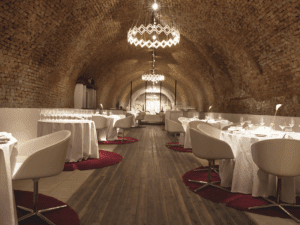 Restaurant Amador
Restaurant Amador
Innovative cooking on the outskirts of town. The three-course lunch—with many extras—is a two-Michelin- star bargain at €69 (and worth it just for the scallop with sweetbread and parsley sauce).
Vestibül Simple,
seasonal cooking in a grand setting at the imperial coach entrance of the Burgtheater, with a terrace overlooking the Ringstrasse. The food is updated classic Austrian, with exemplary veal dishes.
DAY 2:
Well, this is interesting: we are on our bikes, headed downhill on a notable slope, and I am pedalling hard. Why? Am I feeling anti-social, hoping to outpace my wife and maybe set a land speed record in the process? No. I am trying not to fall over. Because a few long minutes ago, when I stopped pedalling, I came to a full stop, immediately. That’s how hard the bloody wind is blowing: even downhill, if you don’t pedal, you won’t move.
The Burgenland is wind farm territory; the region has 404 windmills and now I know why. It also has very pretty countryside and, notably, is home to an ancient lakeside village called Rust. This stunning, quiet town is populated by a handful of people and a whole lot of storks, whose rooftop nests are easily triple the size of the bed our family dog curls up in each night.
We also see the big birds nesting some 15 km away, in Purbach, where we dine that night at Max Stiegl’s Gut Purbach. The restaurant is much-celebrated—and it is easy to see why when you look at the plates going by to other tables. At ours, however, the set menu gives every sign of having been calibrated to please a tour group presumed unadventurous. All good, but deliberately safe, and not so interesting. The wine tasting is extensive but is imposed on us with such disdainful speed by our waiter that a few glasses in, no one can tell one from another. Oh, well.
DAY 3 and 4:
We have passed into Hungary. And while I am already missing Taubenkobel, its S&M loft décor and breakfasts—among the best I’ve ever eaten in a hotel anywhere—it must be said that the scenery on this side of the border is much more compelling. There is much more forest. And—a mixed blessing, this—more varied topography.
“Do-do-da-dooo!” my GPS-activated tablet bleats as it passes through one of the invisible markers on its programmed map, and makes one of its pre-recorded announcements about the road ahead. “Turn right, go up the hill and continue on to the vineyard.”
The hill to the right is steep and long. I pull over to rest and prepare myself.
“…go up the hill and continue to the f—king hospital, more like,” Lisa says, as she passes me by.
As we approach Lake Balaton, passing through the lovely hillside vineyards that surround it, things get easier and prettier still. But, having descended to the shoreline of the vast, turquoise-hued lake for a lakeside lunch, we of course must climb back out of the valley to get to our next hotel, up in the hills.
And what a climb it is.
Slow down to see the world, the B&R slogan reads.
“Isn’t that what bars are for?” I am thinking. How can you see anything from a bike, eyes fixed on the challenges and perils of the road ahead? What’s wrong with convertibles?
This afternoon, every turn in the road reveals another hill lurking behind it, and on and on it goes. Finally, after hours of pushing, we turn the final corner and at last see the hotel parking lot, just up the last hill. There, at the finish line at the top, I can make out Raffa, waiting with his chilled water bottles. I downshift all the way for the last push. Taking stock of my rubbery legs and sore bottom, I figure I can probably make it to him without stopping, just. But no further.
And I mean no further. Like, if he were waiting even 10 feet higher up the hill, I would not make it, no way. Not under any circumstances. Even if there were a grizzly bear bounding up the hill behind me, teeth gnashing and drool flowing, and I riding naked, wearing nothing but a raw salmon tied around my neck, I’d still have to pull over and take my chances.
I am done.
Dinner that night at Villa Vitae, our strange, Holiday Inn-like resort in the hills, is of dubious quality, but mercifully brief—and Lisa and I are happy for the early night. The next evening is immeasurably better. By car–not bike–we visit the Szent Donát winery on Lake Balaton’s north shore, which sits nestled behind beautiful rock gardens overrun with lavender on the village of Csopak’s highest hilltop.
After a leisurely visit to the handsome cellars, we settle in at the restaurant Márga Bisztró to soak up the view from the terrace. And there we enjoy a leisurely tasting of their high-quality and comically affordable terroir-driven wines. We savour the stunning view, then segue to a hearty, accomplished meal—in my case, of consommé and wild boar.
DAY 5:
After one last ride through the Hungarian hills, and a final, rather grim lakeside lunch (frozen French fries, the works), we bid our bicycles adieu, transfer to a bus and then— at a small marina on the Danube—to a pair of Venetian-style mahogany Riva powerboats. Next, with a glass of warm, cheap fizz in hand and grating AC/DC blaring, we rip down the Danube, passing under the magnificent Széchenyi Chain Bridge and, flanked by the glorious buildings and monuments of Buda and Pest, make for the dock near our last stop: the Gresham Palace. At last: one small bottle of water and two large dry martinis, please.
Visiting Budapest
WHERE TO STAY:
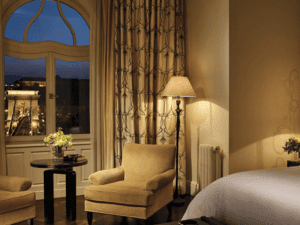 Gresham Palace
Gresham Palace
This magnificent Art Nouveau building started life as an office tower, then languished as an apartment block during the Communist era before being restored and relaunched as a grand, Four Seasons- managed luxury hotel in 2004. If you can, book a room on the riverside, and enjoy stunning views of the Chain Bridge and the Buda side of the city across the Danube.
Hotel Rum
Or, for a small fraction of the cost of the Gresham, you can shack up very comfortably with the trendier, younger set at the Hotel Rum. This boutique hotel has an equally convenient location, a rooftop bar, and modern, locally conceived design that feels international, but also of its place.
WHERE TO EAT:
For something old-school and assertively local, try Café Kör, a comfortable room with arched ceilings, dark wood, and simple, hearty food. Grilled goose liver with apples, veal schnitzel, the inevitable beef goulash— and plenty more.
Kispiac Bisztró
This tiny bistro with sidewalk seating is extremely charming, offering modestly priced and hearty fare perfect for a cold winter night—even in mid-summer. Order something from the rotisserie, go hardcore with tripe goulash or, best yet, try the grilled duck, which is succulent, crispy and delicious.
Rosenstein
How about this, then? A two-generation, Jewish family-run restaurant where the menu starts with a quote from Brillat-Savarin, spans cholent (with paprika and eggs), stuffed cabbage, a consommé studded with huge cubes of goose foie gras, and even a game section (say, braised venison with dumplings and sour cream). There is no more pleasurable or fattening way to learn about Jewish-Hungarian tradition than in the cozy and welcoming fine-dining setting of Rosenstein.
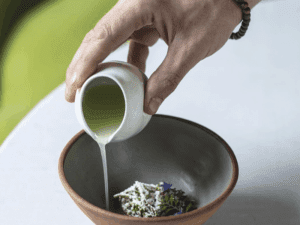 Babel
Babel
This very modern restaurant pays attention to both tradition and culinary trendiness. Transylvanian chef István Veres works with fine local ingredients to update Hungarian classics with a light touch—as in spätzle with truffle foam. Roast loin of Transylvanian venison with celeriac, wild mushrooms and charcoal oil is a standout. They even have a vegan tasting menu.
Stand25
Stand25 in the Hold Utca chef’s market is a fantastic experience, an amazing lesson in the quality food four talented people can turn out of a 40-square-foot kitchen (granted, the chefs behind it–Szulló Szabina and Széll Tamás–were surprise winners of the European finals for the 2016 Bocuse d’Or). Lamb paté is exquisite, and the goulash, rich, smoky, aromatic perfection.
Odyssey On Two Wheels
Jacob Richler tackles a challenging mix of fitness, Riesling and schnitzel on the new Butterfield & Robinson gastro-cycling tour from Vienna to Budapest
MY WIFE LISA AND I have signed up for a five-day jaunt with Butterfield & Robinson, the Canadian-born adventure travel company for fitness-minded sybarites. The itinerary has us making our way from Vienna to Budapest, through the heart of the onetime Austro-Hungarian Empire, stopping in on mouldering palaces, great restaurants and fine wineries with a view. And in theory, anyway, as we are cycling close to 50 km daily, no amount of eating and drinking should prevent us from completing this little odyssey in a condition commensurate with—if not improved from—our condition when we started.
DAY 1:
Our trip begins at 8:30 am on Sunday, June 17, with a quick rendezvous with our cycling group in the lobby of Vienna’s stately Hotel Sacher (yes, the birthplace of the Sachertorte). From there, we take a 45-minute bus ride east, along the south bank of the Danube, until we escape the capital’s traffic and arrive in a small, quiet town named Deutsch-Haslau. There, B&R has set up a temporary base camp in an obliging local resident’s driveway, where our bicycles await.
We are eight cyclists and two guides. Two couples from Minneapolis are old friends and veterans of a half-dozen of these B&R adventures. Another couple, first-timers like us, are from New York. Our two young (and worrisomely fit-looking) guides, Ernesto and Raffa, are European, extensively travelled and fluent in all the necessary languages.
Ernesto begins our briefing with much advice on road safety. Then a little more, just to be safe. And finally, something important: a detailed explanation of how to use our bicycles’ handlebar-mounted tablet computers. Their GPS-connected roadmaps are activated by GPS markers to voice-prompt upcoming turns in the road, distance to the finish line, you name it. With B&R, I surmise, there is no need to follow the leader or the gang; the tablet is our ticket to independence. Good stuff.
The day is glorious, hot and clear, with a mild breeze alleviating the full-on assault of the sun. We set off. Over the next 15 kilometres or so, we learn that Austria has nice bike paths and courteous drivers. And—at least in our neck of the woods—an awful lot of warehouses, garages and bleak roadways. Finally, the scenery begins to improve as we approach Lake Neusiedl— Austria’s largest, albeit not much deeper than a wading pool–and pull up for lunch at Mole West, a large lakeside marina restaurant, for our first group meal.
The Riesling is lovely, the food indifferent, and two hours later we are back on our bikes. And save for the occasional mobile refreshment pit stops that B&R sets up on the roadside, our bike seats are where we stay for the rest of the afternoon, for another two hours and then some of perspiration and exertion.
This five-hours-in-a single-day on a hard bicycle seat is a first for me. I spend some large part of the afternoon telegraphing thank-yous to an old friend back home who talked me into spending what I thought to be an exorbitant sum on a cutting-edge pair of spandex cycling shorts, which have cushioning gel packs stitched into their bottoms—just like a Kardashian.
At last we arrive at our first hotel, Taubenkobel, in the Burgenland village of Schützen am Gebirge. The diminutive property somehow comprises a hotel, restaurant, terrace, gardens and a lily pond filled with unusually loquacious frogs. The compound looks to have grown organically, built very much by hand, all integrated seamlessly into a 19th-century farmhouse with an effect that is equal parts charming, romantic and eccentric.
Actually, no; the emphasis is on the latter. For example, our cozy bedroom— complete with turntable, records and a bar—also has a loft, accessible by ladder and occupied by a knockoff of Allen Jones‘ iconic ’60s sculpture of a semi-naked woman in bondage gear on all fours with a glass table top mounted on her back. I have a martini with her, and then it’s time for dinner.
An exceptional, genuinely exquisite, original and emphatically memorable dinner. Trout crudo with radish and caramel followed by local pike in garlic and rosehip broth, a dazzling course of local charcuterie and one of the single best pigeons (succulent, smoky from the wood fire) I’ve ever tasted. We close with a unique dessert of locally foraged bitter greens, rhubarb and fresh almonds. Each course is paired with an exceptional local wine. We sleep very well.
Visiting Vienna
WHERE TO STAY:
 Grand Ferdinand
Grand Ferdinand
Contemporary furnishings, comfortable spacious rooms, a good lobby restaurant and streetside patio bar in the Schubertring, and a complimentary breakfast on a rooftop patio with splendid views of the old city—for a third of the price of the Hotel Sacher.
WHERE TO EAT:
A small, charming fish restaurant with a small sidewalk patio.Excellent selection of fish and seafood, mostly from the North Sea. Contemporary cooking, excellent local wines, very reasonable prices.
Steirerek
Highly contemporary, extremely polished Austrian cuisine in a stunning setting in the Stadtpark. Do not miss chef Reitbauer’s signature dish of Arctic char cooked in hot beeswax, with glazed yellow carrots, sour cream and pollen.
 Restaurant Amador
Restaurant Amador
Innovative cooking on the outskirts of town. The three-course lunch—with many extras—is a two-Michelin- star bargain at €69 (and worth it just for the scallop with sweetbread and parsley sauce).
Vestibül Simple,
seasonal cooking in a grand setting at the imperial coach entrance of the Burgtheater, with a terrace overlooking the Ringstrasse. The food is updated classic Austrian, with exemplary veal dishes.
DAY 2:
Well, this is interesting: we are on our bikes, headed downhill on a notable slope, and I am pedalling hard. Why? Am I feeling anti-social, hoping to outpace my wife and maybe set a land speed record in the process? No. I am trying not to fall over. Because a few long minutes ago, when I stopped pedalling, I came to a full stop, immediately. That’s how hard the bloody wind is blowing: even downhill, if you don’t pedal, you won’t move.
The Burgenland is wind farm territory; the region has 404 windmills and now I know why. It also has very pretty countryside and, notably, is home to an ancient lakeside village called Rust. This stunning, quiet town is populated by a handful of people and a whole lot of storks, whose rooftop nests are easily triple the size of the bed our family dog curls up in each night.
We also see the big birds nesting some 15 km away, in Purbach, where we dine that night at Max Stiegl’s Gut Purbach. The restaurant is much-celebrated—and it is easy to see why when you look at the plates going by to other tables. At ours, however, the set menu gives every sign of having been calibrated to please a tour group presumed unadventurous. All good, but deliberately safe, and not so interesting. The wine tasting is extensive but is imposed on us with such disdainful speed by our waiter that a few glasses in, no one can tell one from another. Oh, well.
DAY 3 and 4:
We have passed into Hungary. And while I am already missing Taubenkobel, its S&M loft décor and breakfasts—among the best I’ve ever eaten in a hotel anywhere—it must be said that the scenery on this side of the border is much more compelling. There is much more forest. And—a mixed blessing, this—more varied topography.
“Do-do-da-dooo!” my GPS-activated tablet bleats as it passes through one of the invisible markers on its programmed map, and makes one of its pre-recorded announcements about the road ahead. “Turn right, go up the hill and continue on to the vineyard.”
The hill to the right is steep and long. I pull over to rest and prepare myself.
“…go up the hill and continue to the f—king hospital, more like,” Lisa says, as she passes me by.
As we approach Lake Balaton, passing through the lovely hillside vineyards that surround it, things get easier and prettier still. But, having descended to the shoreline of the vast, turquoise-hued lake for a lakeside lunch, we of course must climb back out of the valley to get to our next hotel, up in the hills.
And what a climb it is.
Slow down to see the world, the B&R slogan reads.
“Isn’t that what bars are for?” I am thinking. How can you see anything from a bike, eyes fixed on the challenges and perils of the road ahead? What’s wrong with convertibles?
This afternoon, every turn in the road reveals another hill lurking behind it, and on and on it goes. Finally, after hours of pushing, we turn the final corner and at last see the hotel parking lot, just up the last hill. There, at the finish line at the top, I can make out Raffa, waiting with his chilled water bottles. I downshift all the way for the last push. Taking stock of my rubbery legs and sore bottom, I figure I can probably make it to him without stopping, just. But no further.
And I mean no further. Like, if he were waiting even 10 feet higher up the hill, I would not make it, no way. Not under any circumstances. Even if there were a grizzly bear bounding up the hill behind me, teeth gnashing and drool flowing, and I riding naked, wearing nothing but a raw salmon tied around my neck, I’d still have to pull over and take my chances.
I am done.
Dinner that night at Villa Vitae, our strange, Holiday Inn-like resort in the hills, is of dubious quality, but mercifully brief—and Lisa and I are happy for the early night. The next evening is immeasurably better. By car–not bike–we visit the Szent Donát winery on Lake Balaton’s north shore, which sits nestled behind beautiful rock gardens overrun with lavender on the village of Csopak’s highest hilltop.
After a leisurely visit to the handsome cellars, we settle in at the restaurant Márga Bisztró to soak up the view from the terrace. And there we enjoy a leisurely tasting of their high-quality and comically affordable terroir-driven wines. We savour the stunning view, then segue to a hearty, accomplished meal—in my case, of consommé and wild boar.
DAY 5:
After one last ride through the Hungarian hills, and a final, rather grim lakeside lunch (frozen French fries, the works), we bid our bicycles adieu, transfer to a bus and then— at a small marina on the Danube—to a pair of Venetian-style mahogany Riva powerboats. Next, with a glass of warm, cheap fizz in hand and grating AC/DC blaring, we rip down the Danube, passing under the magnificent Széchenyi Chain Bridge and, flanked by the glorious buildings and monuments of Buda and Pest, make for the dock near our last stop: the Gresham Palace. At last: one small bottle of water and two large dry martinis, please.
Visiting Budapest
WHERE TO STAY:
 Gresham Palace
Gresham Palace
This magnificent Art Nouveau building started life as an office tower, then languished as an apartment block during the Communist era before being restored and relaunched as a grand, Four Seasons- managed luxury hotel in 2004. If you can, book a room on the riverside, and enjoy stunning views of the Chain Bridge and the Buda side of the city across the Danube.
Hotel Rum
Or, for a small fraction of the cost of the Gresham, you can shack up very comfortably with the trendier, younger set at the Hotel Rum. This boutique hotel has an equally convenient location, a rooftop bar, and modern, locally conceived design that feels international, but also of its place.
WHERE TO EAT:
For something old-school and assertively local, try Café Kör, a comfortable room with arched ceilings, dark wood, and simple, hearty food. Grilled goose liver with apples, veal schnitzel, the inevitable beef goulash— and plenty more.
Kispiac Bisztró
This tiny bistro with sidewalk seating is extremely charming, offering modestly priced and hearty fare perfect for a cold winter night—even in mid-summer. Order something from the rotisserie, go hardcore with tripe goulash or, best yet, try the grilled duck, which is succulent, crispy and delicious.
Rosenstein
How about this, then? A two-generation, Jewish family-run restaurant where the menu starts with a quote from Brillat-Savarin, spans cholent (with paprika and eggs), stuffed cabbage, a consommé studded with huge cubes of goose foie gras, and even a game section (say, braised venison with dumplings and sour cream). There is no more pleasurable or fattening way to learn about Jewish-Hungarian tradition than in the cozy and welcoming fine-dining setting of Rosenstein.
 Babel
Babel
This very modern restaurant pays attention to both tradition and culinary trendiness. Transylvanian chef István Veres works with fine local ingredients to update Hungarian classics with a light touch—as in spätzle with truffle foam. Roast loin of Transylvanian venison with celeriac, wild mushrooms and charcoal oil is a standout. They even have a vegan tasting menu.
Stand25
Stand25 in the Hold Utca chef’s market is a fantastic experience, an amazing lesson in the quality food four talented people can turn out of a 40-square-foot kitchen (granted, the chefs behind it–Szulló Szabina and Széll Tamás–were surprise winners of the European finals for the 2016 Bocuse d’Or). Lamb paté is exquisite, and the goulash, rich, smoky, aromatic perfection.


